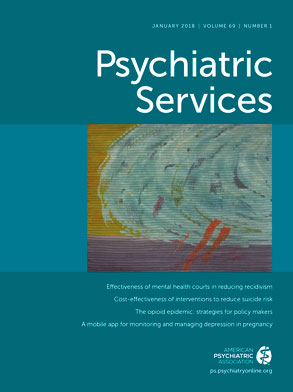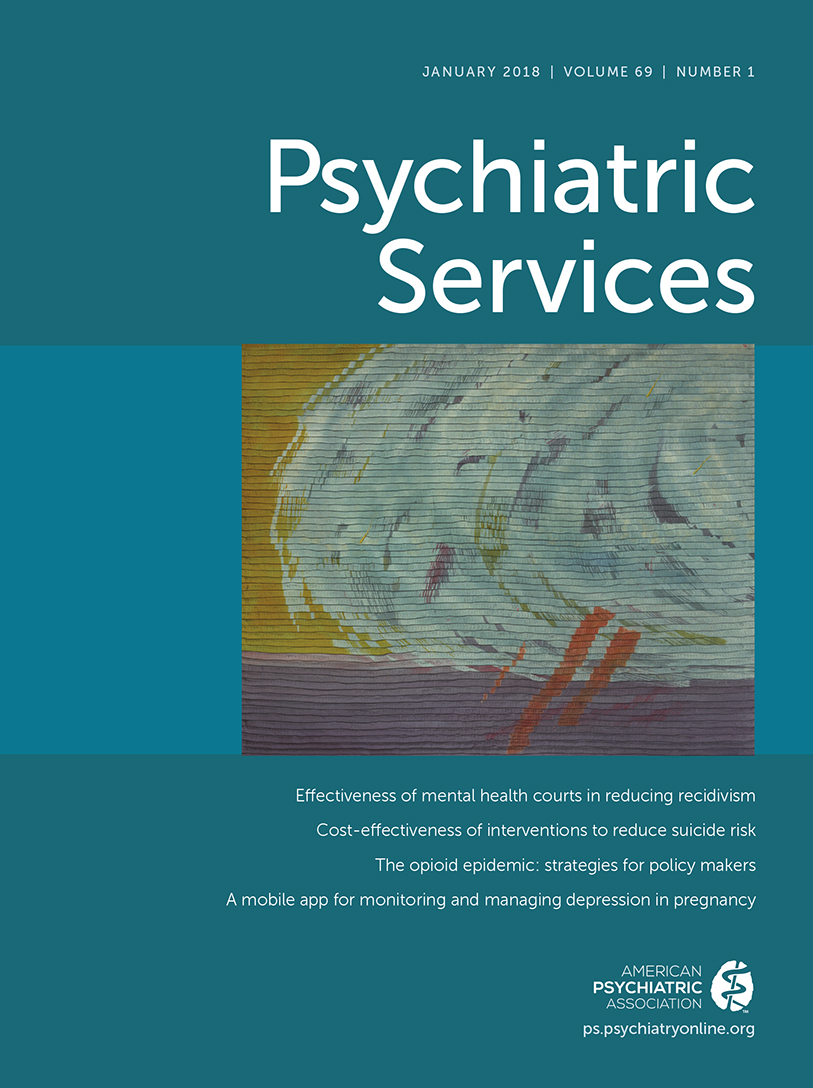Evaluating the Implementation of Home-Based Videoconferencing for Providing Mental Health Services
Abstract
Objective:
Methods:
Results:
Conclusions:
Methods
Participants

Procedures
Qualitative Data Coding
Results
| Site 1 (N=12) | Site 2 (N=13) | Site 3 (N=8) | Total (N=33) | |||||
|---|---|---|---|---|---|---|---|---|
| Characteristic | N | % | N | % | N | % | N | % |
| Staff type | ||||||||
| Provider | ||||||||
| Psychologist | 5 | 42 | 0 | — | 4 | 50 | 9 | 27 |
| Psychiatrist | 1 | 8 | 2 | 15 | 0 | — | 3 | 9 |
| Social worker | 4 | 33 | 7 | 54 | 1 | 13 | 12 | 36 |
| Nurse | 0 | — | 3 | 23 | 1 | 13 | 4 | 12 |
| Total | 10 | 83 | 12 | 92 | 6 | 75 | 28 | 85 |
| Nonprovider | ||||||||
| Telehealth staffa | 2 | 17 | 1 | 8 | 1 | 13 | 4 | 12 |
| Program analyst | 0 | — | 0 | — | 1 | 13 | 1 | 3 |
| Total | 2 | 17 | 1 | 8 | 2 | 25 | 5 | 15 |
| V2H experience | ||||||||
| No direct experience | 4 | 33 | 9 | 69 | 0 | — | 13 | 39 |
| Limited experience | 3 | 25 | 2 | 15 | 2 | 25 | 7 | 21 |
| Most experienceb | 5 | 42 | 2 | 15 | 6 | 75 | 13 | 39 |
| CFIR domain, construct, and subsconstruct | Relevance to V2H implementationa | Recommended implementation strategiesb |
|---|---|---|
| Intervention characteristics | ||
| Complexity | Perceived difficulty of implementation, reflected by duration, intricacy, and number of steps involved | Provide local and ongoing logistical and technical support |
| Functionality problems | Provide local and ongoing logistical and technical support | |
| Intervention source, external | Perception that intervention is externally developed or mandated | Conduct local consensus discussions |
| Outer setting | ||
| Patient needs and resources | ||
| Perceived patient need for V2H | Align V2H performance measure goals with areas of patient need | |
| Access | Patients’ access to needed V2H equipment (computer, Webcam) | Provide Webcams to patients |
| Patient perspectives | Perceived patient preference for and satisfaction with V2H | Provide logistical and technical support directly for patients |
| External policy and incentives | Performance measures that incentive V2H implementation | Conduct local consensus discussions |
| Inner setting | . | |
| Compatibility | Degree of tangible fit between V2H and mental health practice | Conduct educational meeting that addresses compatibility concerns and adaptations to address those concerns |
| Leadership engagement | Commitment, involvement, and accountability of leaders and managers with the implementation | Involve leaders with aligning implementation efforts in areas of greatest need, provision of protected time, identifying resources |
| Available resources | ||
| Implementation staff | Availability of staff to provide logical support, training, and ongoing assistance | Identify and train implementation leaders; develop quality monitoring systems to track key implementation metrics (such as average length of time for provider setup and N of sessions canceled due to technology problems) |
| Dedicated time | Provision of protected time for V2H telehealth | Revise professional roles for providers adopting V2H (discuss productivity adjustments to allow time for V2H adoption) |
| Access to knowledge and information | Access to information about V2H setup and use | Develop educational materials that streamline provider and patient setup |
| Characteristics of individuals | ||
| Self-efficacy | Individuals’ belief in their own capability to set up and utilize V2H | Assign point-of-contact to facilitate provider setup and address ongoing V2H needs and concentrate logistical support during early phase of provider adoption |
| Process | ||
| Engaging patients | Strategies for engaging patients with V2H | Align patient engagement with areas of need, engage in directly marketing V2H to patients, and design system-level tools for identifying appropriate patient candidates (such as assessing need at triage/referral points) |
| Engaging providers | Strategies for engaging staff or providers to adopt V2H or increase its availability | Conduct educational outreach |
| Champion | Dedicated individuals involved with generating V2H interest, engagement, adoptions, and overcoming resistance | Identify and prepare a local champion |
Aim 1: CFIR Constructs and Level of V2H Experience
No direct V2H experience.
Limited V2H experience.
Also, although providers with no direct V2H experience had not been exposed to functionality problems (technical problems), such difficulties begin to emerge among those with at least limited V2H experience. These included instances of difficulty connecting or of poor sound. Other challenges included finding patients who were interested in telehealth (instead of face-to-face contact) and who had the needed technology in their home (patient needs and resources [patient perspectives and barriers subconstruct]). According to a provider with limited experience,I do remember it being like, the trainings were kind of difficult, there wasn’t a lot of guidance . . . and I had trouble figuring out who was supposed to actually come and see me do that, and then they worked it out, but that was kind of complicated. (participant 9, facility 3)
Altogether, the set of findings for participants with limited V2H experience indicate that once engaged to adopt V2H telehealth, providers will subsequently encounter a number of logistical barriers. Two quotes by a participant with limited V2H experience illustrate how logistical barriers can negatively affect enthusiasm for V2H services. “I love [V2H] for a lot of reasons,” he said. “I feel like . . .we’ve entered a different era of how we deliver services and . . . treatment is more patient centered.” Yet the same participant reported concerns about functionality problems: “I think there’s sort of a sense that beyond the first couple of meetings, . . . the effort and the concern about it working may not make it worth it at this point” (participant 28, facility 1).Actually, we haven't had a lot of [patients] who want to do [V2H]. . . . They want to come in and do face-to-face. . . . We offer this to everybody, but I only have two people . . . who wanted to do [V2H]. There might have been some people that I talked about this with in the past and might have wanted to do it, but then say, “Oh I don't have a Webcam.” (participant 4, facility 1)
Most V2H experience.
It was a lot more scattered I remember when I first started. Like what do I do next? It would be weeks in between each step. . . . I didn’t have another job. . . . If you’re already in your job full time, you don’t have time for all those things. (participant 22, facility 2)
Aim 2: Factors Among Different Facilities
Facility 1.
Facility 2.
Several participants at facility 2 described a process to engage providers to adopt V2H (engaging providers). E-mails eliciting interest were sent to providers, and those who were interested were invited to a subsequent V2H in-service training. The training was followed by discussions that focused on areas of need and methods for making V2H available. Moreover, ongoing logistical support was provided by the local champion, in terms of explaining the process, demonstrations of the equipment, compiling resources, and follow-up assistance (available resources [implementation staff support subconstruct]). The availability of this support may have mitigated some of the barriers, such as setup complexity and technology problems, given that these barriers were reported to have the least negative impact at this facility.Sure, I have not done it at all myself. . . . I know more about it from [the champion] really and just the work that she’s been doing. She loves it. She just thinks it’s a great service. . . . So I have been thinking about it. (participant 6, facility 2)
Facility 3.
The push for telehealth in general, and numbers in general, I’m not particularly a fan of, as opposed to pushing the use of V2H as it’s needed for [patients]. . . . There’s a high concentration of [outpatient clinics] that have mental health [services]. So most people that I meet prefer to do it in person, and this push for numbers . . . feels arbitrary. (participant 9, facility 3)
Discussion
Conclusions
Acknowledgments
Supplementary Material
- View/Download
- 168.51 KB
References
Information & Authors
Information
Published In

Cover: Understanding, by Michael Olszewski, 1984. Dyed and pleated silk plain weave with silk embroidery. Philadelphia Museum of Art, gift of Nancy and David Bergman, 2015.
History
Keywords
Keywords
Authors
Competing Interests
Funding Information
Metrics & Citations
Metrics
Citations
Export Citations
If you have the appropriate software installed, you can download article citation data to the citation manager of your choice. Simply select your manager software from the list below and click Download.
For more information or tips please see 'Downloading to a citation manager' in the Help menu.
View Options
View options
PDF/EPUB
View PDF/EPUBLogin options
Already a subscriber? Access your subscription through your login credentials or your institution for full access to this article.
Personal login Institutional Login Open Athens loginNot a subscriber?
PsychiatryOnline subscription options offer access to the DSM-5-TR® library, books, journals, CME, and patient resources. This all-in-one virtual library provides psychiatrists and mental health professionals with key resources for diagnosis, treatment, research, and professional development.
Need more help? PsychiatryOnline Customer Service may be reached by emailing [email protected] or by calling 800-368-5777 (in the U.S.) or 703-907-7322 (outside the U.S.).
